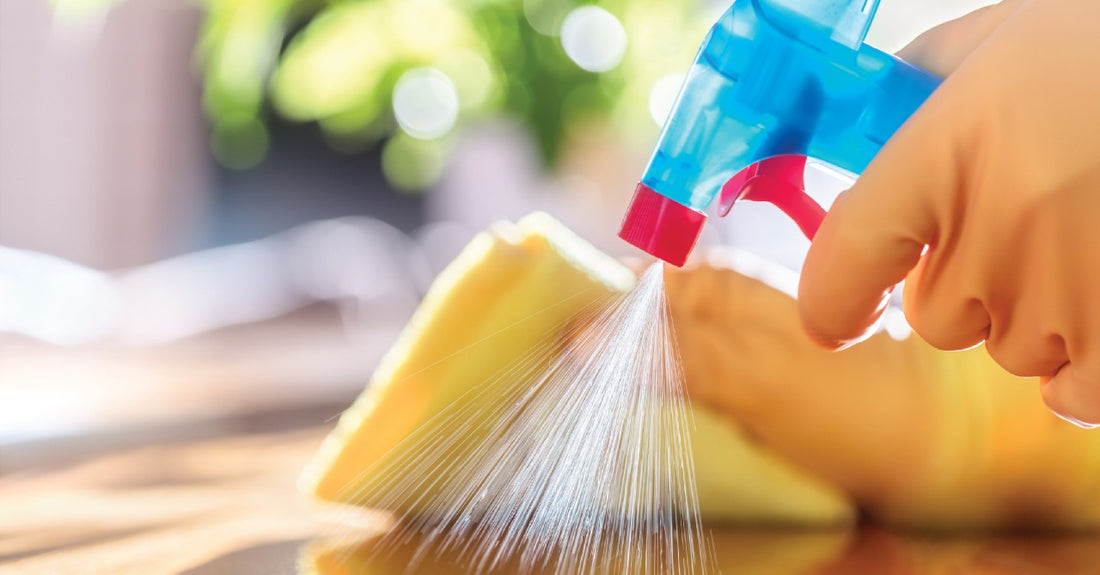Diwali cleaning has long been a trend, but it has never been more necessary to maintain sparkling clean counters and disinfect doorknobs than it is right now. This is because disinfecting regularly touched objects and surfaces every day is one suggested precaution to help prevent the spread of coronavirus disease (COVID-19).
Although experts are still learning more about the virus that causes COVID-19, it is known that it spreads mainly through respiratory droplets from person to person and also through “surface transmission.” This is the term for what can happen when you touch a surface that has coughed or sneezed on by someone with the virus, and then you touch your nose, mouth or eyes. It is assumed that this is the predominant way the virus spreads.
So, maintaining hand hygiene is one way to stop this spread of COVID-19 by either washing your hands with soap and water or using an alcohol-based hand sanitizer. It is also important to keep your home’s high-touch surfaces clean. See the tips for keeping your home safe and tidy during COVID-19. At the Centers for Disease Control and Prevention (CDC) website, you can also learn more about disinfecting your home against Covid.
Tips for cleaning your home during COVID-19 and also disinfecting it:
Clean hard surfaces and disinfect them
The CDC recommends that high-touch surfaces such as chairs, doorknobs, light switches, countertops, desks, phones, keyboards, toilets, faucets, sinks, sports equipment and toys be regularly washed or disinfected by individuals with the use of a disinfectant spray. Be sure to wear disposable gloves when cleaning and use soap and water to pre-clean if an area or object is dirty. Then, to remove germs from surfaces, you should use a disinfectant spray. Use disinfectants that meet the coronavirus treatment requirements of the Environmental Protection Agency (EPA) and are suitable for the surface that you are cleaning. To ensure secure and productive use of the commodity, follow the directions on the label.
Rule No. 1: Without prior washing, don’t use disinfection

For effective disinfection, especially of heavily soiled surfaces, a thorough cleaning with an appropriate detergent is recommended first. Always make sure to use biocides safely. Always read the label before use and the product information.
Disinfection process with a disinfectant
For manual cleaning with cloth and spray bottle:
-Thoroughly clean the item beforehand.
-Enable surface drying to occur.
-Mix the disinfectant liquid with the recommended dose of tap water. •Following the product mark is important.
-Wet the product absolutely with the item.
-Follow the time of reaction as per the mark.
-Rinsing with clean water / Rinsing thoroughly with drinking water for food processing applications.
Using an elevated-pressure cleaner:
-Clean the item first with an acceptable cleaning solution and rinse it with clear water.
-Enable it to dry out.
-Use the product only with cold water when changing the dose on the unit.
-Fully wet the object with the product.
-Note the time of reaction according to the mark.
-Rinse without leaving any trace with tap water.
Use of a spraying unit:
-Using the required dose, blend the liquid with tap water.
-Use the product to absolutely wet the clean and dry item.
-Observe label-based exposure period.
-Rinse without leaving any trace with tap water.
Keep Your Electronics Clean

Tips for Electronic Hygiene: While we become more aware of the effect on our health and societies of the transmission of bacteria and viruses, take the time to build hygiene routines for your devices:
Mobile phones, laptops, phones at the desk, touchpads, keyboards and on/off switches for the monitor and laptop.
Two ways to eliminate germs from mobile devices and computers are as follows:
-Cleaning: physical removal through the washing of germs and impurities from surfaces. This does not destroy the germs, but eliminates them from the surface and reduces the likelihood of transmission. This is like using soap to wash your face.
-Disinfecting: to remove germs living on surfaces by using chemicals. The surface is not actually “cleaned” by disinfecting, but it rids the surface of live viruses and bacteria. The CDC notes that disinfecting a surface will further reduce the risk of spreading germs after washing it. This is like using a sanitizer to disinfect your hand.
Place computers with a wipeable cover. Meet the manufacturer’s washing and disinfecting requirements. A healthy recommendation is to use alcohol-based wipes or sprays that contain at least 70 percent alcohol.
Then, dry the circuitry surface thoroughly.
Don’t forget about soft surfaces

Experts are not sure if for some amount of time the virus that triggers COVID-19 will live on your clothing or bedsheets. It is also recommended, however, that you regularly launder sheets, pillows, clothing and plush toys, particularly if anyone is sick in your home and also otherwise.
How clothes, sheets, linen, and other things should be washed:
– Using the warmest water setting possible and adding a few drops of disinfectant liquid for clothes
– Obey the instructions of the manufacturer.
– Be sure to absolutely dry your products.
– Wear plastic gloves when treating clothing worn by someone who is sick.
– Don’t shake your dusty laundry.
– Make sure to remove your gloves after handling dirty laundry and wash your hands right away.
– Dirty laundry from a person who is ill should not be washed with things from other people.
Hand hygiene exercise when handling products and food containers from outside

It is on everyone’s mind whether or not we should eat from outside and use food delivery apps, especially those cooking on their own. The verdict: It’s a two-way street with some care that you need to approach. “All parties ought to follow safety protocols. You are exposed to the possibility of contamination if the food handler is contaminated and handles anything without following precautions.
In terms of what to order
Ordering cooked food over salads and new juices is recommended. Even, before eating it, reheat the meal. And for purchases, keeping exposure as low as possible is recommended.
Take the remaining money in a pocket if you have to pay by cash and get change back. Wipe with alcohol and place in a zip lock bag if a credit/debit card has been used. Limit in-person interaction as much as possible by shopping online and also making an online payment, using curbside delivery or demanding that deliveries be left outside your house.
Wash your hands or use a sanitizer after getting shipments or taking home take-out food.
Post-Grocery Shopping Procedure

Using a hand sanitiser after leaving your grocery store. When you get home, wash your hands for at least 20 seconds with soap and water. Use a Veggie wash to Disinfect the Fruits and Vegetables from the store and only then consume them. It is not necessary to wipe down cereal boxes and other packages but just a spray of disinfectant will work. After handling them, concentrate on washing your hands. For general food protection, wash your hands for at least 20 seconds with soap and water before cooking or consuming food. Always follow standards for food safety when preparing food.
To minimize COVID-19 exposure when performing important errands, the CDC provides more useful guidance.
If someone in your home gets sick, take special precautions

Even if you take precautions to prevent COVID-19 from spreading, someone in your family will likely get sick. Bear in mind that most people who get sick with COVID-19 will only have mild symptoms and will recover at home. If anyone in your family experiences COVID-19 symptoms, the CDC suggests adopting these cleaning instructions. If necessary, the person who is sick should stay in a separate bedroom with their own bathroom. Interact as little as possible with the person who is sick while also ensuring the treatment that your family member needs.
Ask them to clean their own room if the person who is sick can handle it. By supplying tissues, paper towels, cleaners and disinfectants, you can support them from a distance. Wash the dishes and utensils of a sick person with warm water and soap. Make sure you’re wearing gloves or using a dishwasher. Offer their own lined trash. When handling and disposing of garbage, use gloves and wash your hands afterward.








